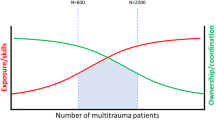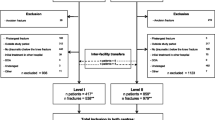Abstract
Interdisciplinary treatment approaches experience a growing acceptance for the treatment of geriatric trauma patients, and they are aiming to reduce peri-/post-operative complications and improve patient outcome. Various studies reported on the effectiveness of an interdisciplinary treatment in elderly trauma patients. Some countries have already included the interdisciplinary approach in their guidelines, i.e. for the treatment of elderly hip fracture patients, thus the “Best Practice Tariff” in the UK and the decision of the German Joint Government Committee (G-BA). Although implementation of a successful ortho-geriatric co-managed model of care varies from one hospital to another, some key elements have to be considered. The present chapter is aiming to provide an overview on the development of a senior trauma centre considering the key elements, role players and their interaction with each other, such as the presentation of required structural adjustments and approaches for secondary fracture prevention.
Access this chapter
Tax calculation will be finalised at checkout
Purchases are for personal use only
Similar content being viewed by others
References
Lisk R, Yeong K. Reducing mortality from hip fractures: a systematic quality improvement programme. BMJ Qual Improv Rep. 2014;3
Khan SK, Jameson SS, Avery PJ, et al. Does the timing of presentation of neck of femur fractures affect the outcome of surgical intervention. Eur J Emerg Med. 2013;20:178–81.
Juliebo V, Bjoro K, Krogseth M, et al. Risk factors for preoperative and postoperative delirium in elderly patients with hip fracture. J Am Geriatrics Soc. 2009;57:1354–61.
Lee KH, Ha YC, Lee YK, et al. Frequency, risk factors, and prognosis of prolonged delirium in elderly patients after hip fracture surgery. Clin Orthop Relat Res. 2011;469:2612–20.
Murphy C, Mullen E, Hogan K, et al. Streamlining an existing hip fracture patient pathway in an acute tertiary adult Irish hospital to improve patient experience and outcomes. Int J Qual Health Care. 2019;31:45–51.
Ogilvie-Harris DJ, Botsford DJ, Hawker RW. Elderly patients with hip fractures: improved outcome with the use of care maps with high-quality medical and nursing protocols. J Orthop Trauma. 1993;7:428–37.
(G-Ba) GB. Beschluss des Gemeinsamen Bundesausschusses über eine Richtlinie zur Versorgung der hüftgelenknahen Femurfraktur; 2019.
Khan SK, Weusten A, Bonczek S, et al. The Best Practice Tariff helps improve management of neck of femur fractures: a completed audit loop. Br J Hosp Med (Lond). 2013;74:644–7.
Kammerlander C, Roth T, Friedman SM, et al. Ortho-geriatric service--a literature review comparing different models. Osteoporos Int. 2010;21:S637–46.
Pioli G, Giusti A, A B (2008) Orthogeriatric care for the elderly with hip fractures: where are we? Aging Clin Exp Res 20:113–122
Buecking B, Struewer J, Waldermann A, et al. What determines health-related quality of life in hip fracture patients at the end of acute care?—A prospective observational study. Osteoporos Int. 2014;25:475–84.
Prestmo A, Hagen G, Sletvold O, et al. Comprehensive geriatric care for patients with hip fractures: a prospective, randomised, controlled trial. Lancet. 2015;385:1623–33.
Rapp K, Becker C, Todd C, et al. The association between orthogeriatric co-management and mortality following hip fracture. Dtsch Arztebl Int. 2020;117:53–9.
Friedman S, Mendelson D, Kates S, et al. Geriatric co-management of proximal femur fractures: total quality management and protocol-driven care result in better outcomes for a frail patient population. J Am Geriatrics Soc. 2008;56:1349–56.
Kates SL, Mendelson DA, Friedman SM. Co-managed care for fragility hip fractures (Rochester model). Osteoporos Int. 2010;21:S621–5.
Shyu Y-IL, Liang J, Wu C-C, et al. Interdisciplinary intervention for hip fracture in older Taiwanese: benefits last for 1 year. J Gerontol A Biol Sci Med Sci. 2008;63:92–7.
Kammerlander C, Gosch M, Blauth M, et al. The Tyrolean Geriatric Fracture Center: an orthogeriatric co-management model. Zeitschrift fur Gerontologie und Geriatrie. 2011;44:363–7.
Singler K, Biber R, Wicklein S, et al. “N-active”: a new comanaged, orthogeriatric ward: observations and prospects. Zeitschrift fur Gerontologie und Geriatrie. 2011;44:368–74.
Kates SL, Mendelson DA, Friedman SM. The value of an organized fracture program for the elderly: early results. J Orthop Trauma. 2011;25:233–7.
Mendelson DA, Friedman SM. Principles of comanagement and the geriatric fracture center. Clin Geriatr Med. 2014;30:183–9.
Luger TJ, Kammerlander C, Luger MF, et al. Mode of anesthesia, mortality and outcome in geriatric patients. Zeitschrift fur Gerontologie und Geriatrie. 2014;47:110–24.
Kowark A, Adam C, Ahrens J, et al. Improve hip fracture outcome in the elderly patient (iHOPE): a study protocol for a pragmatic, multicentre randomised controlled trial to test the efficacy of spinal versus general anaesthesia. BMJ Open. 2018;8:e023609.
Inouye SK. Delirium in older persons. N Engl J Med. 2006;354:1157–65.
Gosch M, Nicholas JA. Pharmacologic prevention of postoperative delirium. Zeitschrift fur Gerontologie und Geriatrie. 2014;47:105–9.
Liem IS, Kammerlander C, Suhm N, et al. Identifying a standard set of outcome parameters for the evaluation of orthogeriatric co-management for hip fractures. Injury. 2013;44:1403–12.
Werther SFJ, Mayr E. Interdisziplinäres Management im Zentrum für geriatrische Traumatologie. Orthopädie und Unfallchirurgie up2date. 2014;5:387–406.
Bonaiuti D, Shea B, Iovine R, et al. Exercise for preventing and treating osteoporosis in postmenopausal women. Cochrane Database Syst Rev. 2002:CD000333.
Huuskonen J, Vaisanen SB, Kroger H, et al. Regular physical exercise and bone mineral density: a four-year controlled randomized trial in middle-aged men. The DNASCO study. Osteoporos Int. 2001;12:349–55.
Willburger RE, Knorth H. Osteoporose der Wirbelsäule: Therapieoption und Präventionsstrategien. Dtsch Arztebl Int. 2003;100:1120.
Kammerlander C, Pfeufer D, Lisitano LA, et al. Inability of older adult patients with hip fracture to maintain postoperative weight-bearing restrictions. J Bone Joint Surg Am. 2018;100:936–41.
Siu AL, Penrod JD, Boockvar KS, et al. Early ambulation after hip fracture: effects on function and mortality. Arch Intern Med. 2006;166:766–71.
Hill K. Additional physiotherapy during acute care reduces falls in the first 12 months after hip fracture. J Physiother. 2010;56:201.
Ottesen TD, Mclynn RP, Galivanche AR, et al. Increased complications in geriatric patients with a fracture of the hip whose postoperative weight-bearing is restricted: an analysis of 4918 patients. Bone Joint J. 2018;100-B:1377–84.
Lunt M, Masaryk P, Scheidt-Nave C, et al. The effects of lifestyle, dietary dairy intake and diabetes on bone density and vertebral deformity prevalence: the EVOS study. Osteoporos Int. 2001;12:688–98.
Oh ES, Fong TG, Hshieh TT, et al. Delirium in older persons: advances in diagnosis and treatment. JAMA. 2017;318:1161–74.
Mayr E, Blauth M, Kates S, et al. 2.5 Adapting facilities to fragility fracture patients. In: Osteoporotic fracture care. Georg Thieme Verlag; 2019.
Neuerburg C, Forch S, Gleich J, et al. Improved outcome in hip fracture patients in the aging population following co-managed care compared to conventional surgical treatment: a retrospective, dual-center cohort study. BMC Geriatr. 2019;19:330.
Pils K, Muller W, Likar R, et al. Rehabilitation after hip fracture. Wiener medizinische Wochenschrift. 2013;163:462–7.
Givens JL, Sanft TB, Marcantonio ER. Functional recovery after hip fracture: the combined effects of depressive symptoms, cognitive impairment, and delirium. J Am Geriatrics Soc. 2008;56:1075–9.
Huusko TM, Karppi P, Avikainen V, et al. Intensive geriatric rehabilitation of hip fracture patients: a randomized, controlled trial. Acta Ortho Scand. 2002;73:425–31.
Schray D, Neuerburg C, Stein J, et al. Value of a coordinated management of osteoporosis via Fracture Liaison Service for the treatment of orthogeriatric patients. Eur J Trauma Emerg Surg. 2016;42:559–64.
Ryg J, Rejnmark L, Overgaard S, et al. Hip fracture patients at risk of second hip fracture: a nationwide population-based cohort study of 169,145 cases during 1977-2001. J Bone Miner Res. 2009;24:1299–307.
Keppler AM, Holzschuh J, Pfeufer D, et al. Postoperative physical activity in orthogeriatric patients—new insights with continuous monitoring. Injury. 2020;51:628–32.
Pfeufer D, Zeller A, Mehaffey S, et al. Weight-bearing restrictions reduce postoperative mobility in elderly hip fracture patients. Arch Orthop Trauma Surg. 2019;139:1253–9.
Bryant DM, Sanders DW, Coles CP, et al. Selection of outcome measures for patients with hip fracture. J Orthop Trauma. 2009;23:434–41.
Kammerlander C, Riedmuller P, Gosch M, et al. Functional outcome and mortality in geriatric distal femoral fractures. Injury. 2012;43:1096–101.
Hutchings L, Fox R, Chesser T. Proximal femoral fractures in the elderly: how are we measuring outcome? Injury. 2011;42:1205–13.
Kanis JA, Johnell O. Requirements for DXA for the management of osteoporosis in Europe. Osteoporos Int. 2005;16:229–38.
Author information
Authors and Affiliations
Corresponding author
Editor information
Editors and Affiliations
Rights and permissions
Copyright information
© 2022 Springer Nature Switzerland AG
About this chapter
Cite this chapter
Neuerburg, C., Keppler, A.M., Fleischhacker, E., Gleich, J., Kammerlander, C. (2022). Building A Senior Trauma Centre. In: Pape, HC., Kates, S.L., Hierholzer, C., Bischoff-Ferrari, H.A. (eds) Senior Trauma Patients . Springer, Cham. https://doi.org/10.1007/978-3-030-91483-7_20
Download citation
DOI: https://doi.org/10.1007/978-3-030-91483-7_20
Published:
Publisher Name: Springer, Cham
Print ISBN: 978-3-030-91482-0
Online ISBN: 978-3-030-91483-7
eBook Packages: MedicineMedicine (R0)




